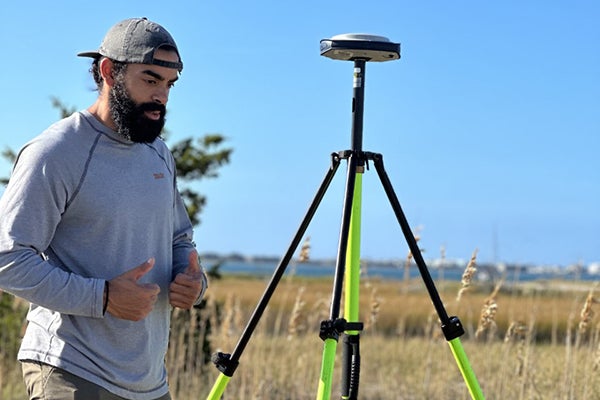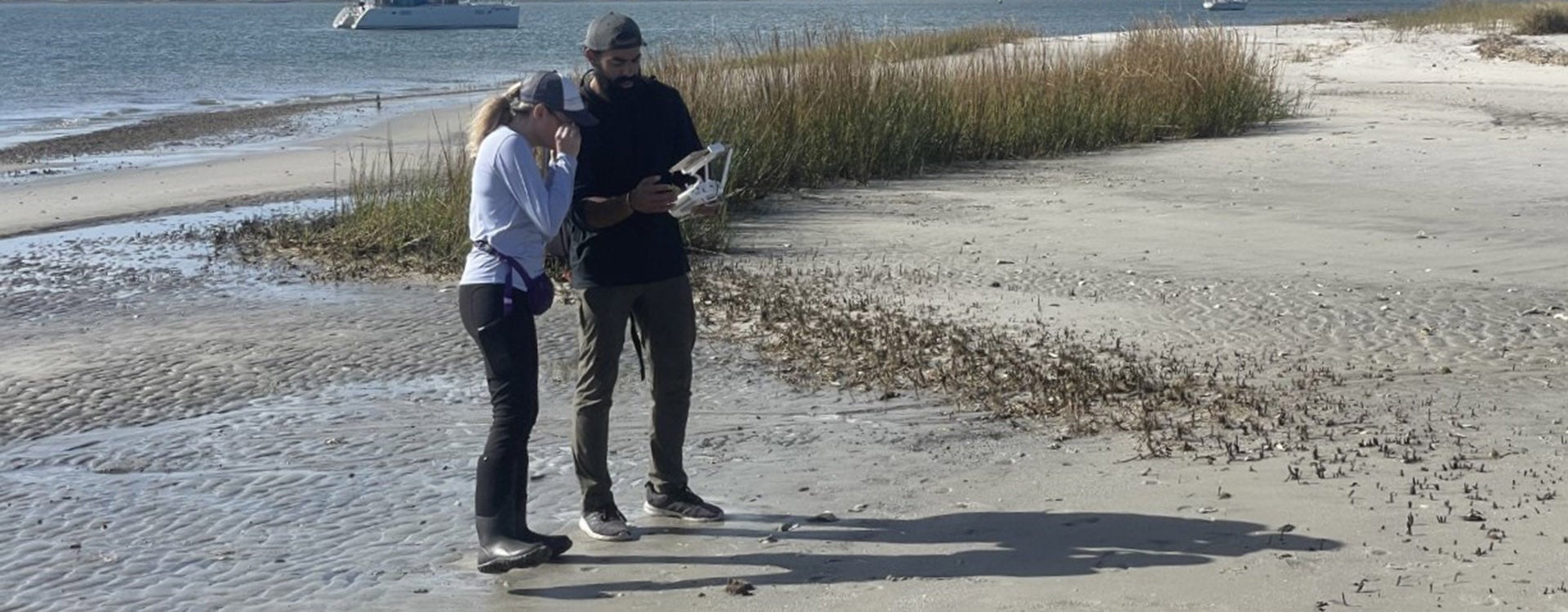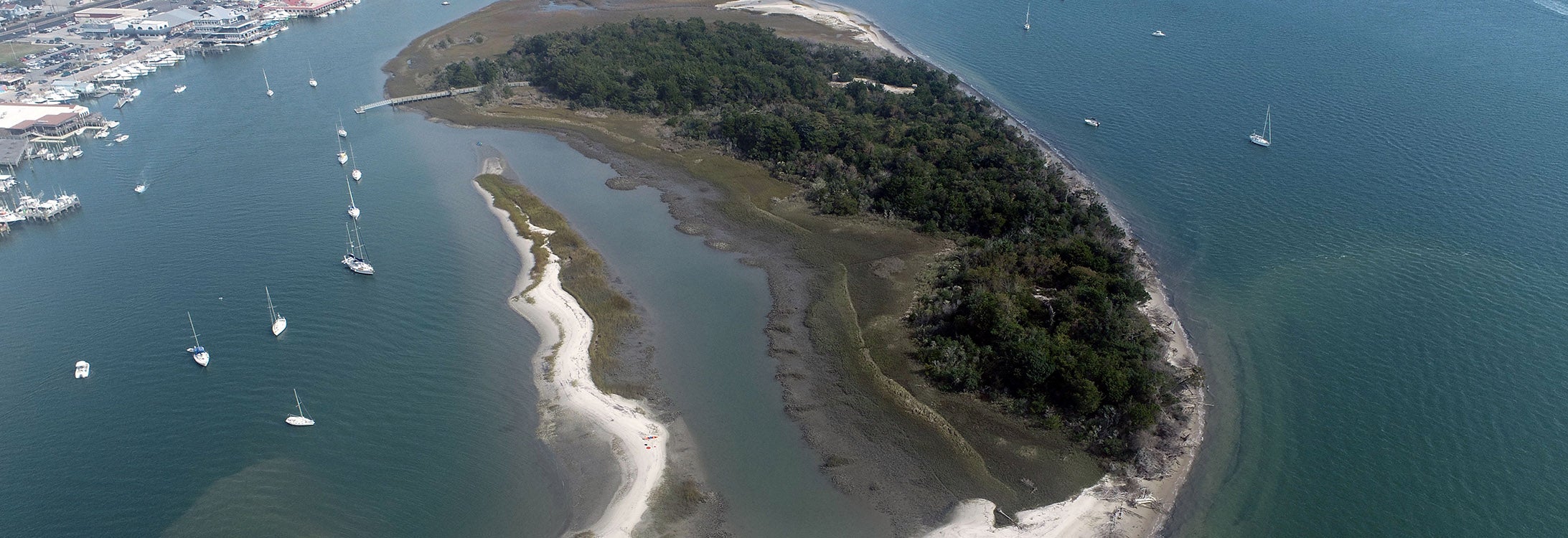DISAPPEARING ISLAND
ECU faculty, students are studying the impact of erosion on Sugarloaf Island
There’s nothing like being at the beach in the summer. The sun is shining, the water is sparkling and the science is flowing. Yes, summertime at the beach is synonymous with science, at least when East Carolina University researchers are out in full force.
Dr. Hannah Sirianni is a Thomas Harriot College of Arts and Sciences assistant professor in the Department of Geography, Planning and Environment who specializes in geographic information science and technology. She is leading a team of researchers and ECU graduate students in studying the erosion of Sugarloaf Island, a popular, undeveloped recreational beach off Morehead City’s downtown waterfront along the North Carolina coast.
“Sugarloaf Island is important to Morehead City because it provides a natural defense from severe storm impacts. Unfortunately, there are growing concerns over the island’s severe erosion problem,” Sirianni said.
Since 2014, the island’s shoreline has eroded about 10 feet per year and lost nearly 10,000 cubic meters of sand. It would take 800 average-sized dump trucks to hold the amount of sand lost from the 47-acre island.
“Sugarloaf Island is clearly disappearing at an alarming rate, and something needs to be done,” she said.
Sirianni’s team includes a group of multidisciplinary scientists, engineers and administrators from ECU, as well as leaders and representatives from local government, academic and business entities that include the town of Morehead City, North Carolina Coastal Federation, UNC Institute of Marine Sciences, Sea & Shoreline LLC, and Quible and Associates.
ECU animation by Kevin Treadway. Watch this video on YouTube.
The group is working together to design and implement a restoration project of shoreline stabilization techniques to help mitigate the erosion on the island. Stabilization techniques may include wave attenuation devices, living shoreline oyster reefs and terrestrial/aquatic plantings.
This summer, to aid the project, Sirianni’s Coastal Geography and Terrain Analysis lab used cutting-edge geospatial technologies, including GPS, the global navigation satellite system (GNSS), modeling software and drones to map and monitor seasonal changes to the island.
“The Sugarloaf restoration project provides students with an exciting opportunity to develop real-world field and laboratory skills needed to monitor the success of coastal restoration projects while also giving back to North Carolina’s communities,” Sirianni said.

Moody operates the GNSS to map Sugarloaf Island.
Sirianni’s graduate students Michael Moody and Sarah Pettyjohn are applying the technological skills gained from the project toward their master’s degrees. Moody, who enjoys field research, has helped design field protocols. He conducted an initial drone survey of Sugarloaf Island in November.
“My experience conducting research on Sugarloaf Island has been both enlightening and challenging. The opportunity to work in such a unique and dynamic ecosystem has not only given me a better understanding of the intricacies of barrier island systems but a deeper appreciation for nature as a whole,” Moody said.
Pettyjohn, who found Sirianni’s lab website and Moody’s drone footage of Sugarloaf Island through a Google search, said Sirianni’s research is what attracted her to ECU.
This summer, Sirianni and Moody trained Pettyjohn, who begins her master’s program in geography in the fall. Pettyjohn assisted in current research, monitored the island’s changing shoreline and participated in another drone survey. She will use Moody’s baseline dataset of Sugarloaf Island, along with repeat surveys over the next two years, to better understand the efficacy of the shoreline stabilization techniques on the island and to support knowledge-based decision making along North Carolina’s coastline.
In addition to Moody’s continued research in Sirianni’s lab, he participated in an internship this summer with Florida Fish and Wildlife and intends to complete his master’s degree in geography in spring 2024.
“Dr. Sirianni is an extremely supportive and patient mentor. Through this experience, I have been able to refine my career goals toward habitat restoration, and I am excited for what’s to come, regardless of where I am.”

Dr. Hannah Sirianni, left, reviews the automatic flight parameters with Moody before he conducts a scientific drone survey of Sugarloaf Island.
